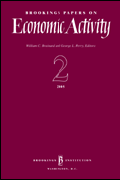Studies in this week’s Hutchins Roundup find that households respond to monetary policy announcements, the Fed can remove deflation bias by responding less aggressively to higher inflation, and more.
Want to receive the Hutchins Roundup as an email? Sign up here to get it in your inbox every Thursday.
Households respond immediately to news about monetary policy
There is ample evidence that financial markets respond to announcements from the Federal Reserve, but do households pay attention to and understand monetary policy news? Daniel J. Lewis of the Federal Reserve Bank of New York, Christos Makridis of MIT Sloan, and Karel Mertens of the Federal Reserve Bank of Dallas use data from a daily survey of households to show that households revise their expectations about the economy in a manner consistent with theory immediately after monetary policy announcements. They find, for example, that individuals become significantly less confident in the state of the economy the day after surprise Fed interest rate hikes, suggesting that news about traditional monetary policy might be transmitted to and internalized by households faster than is commonly assumed. In contrast, Fed announcements providing forward guidance about the future path of interest rates or announcing quantitative easing have smaller and sometimes opposite effects on measures of household confidence. The authors suggest this may be because households do not understand these newer and more complicated policies.
Asymmetric inflation targeting can remove deflation bias
Francesco Bianchi of Duke University, Leonardo Melosi of the Federal Reserve Bank of Chicago, and Matthias Rottner of the European University Institute find that the Federal Reserve’s symmetric inflation targeting framework – promising to respond with similar force when inflation is above its 2% target or below it — is unwise when the long-run nominal interest rate is low, as it is now. The authors reason that individuals anticipate that a central bank will be unable to revive the economy after a downturn because it can’t cut rates much below zero. As a result, the economy faces deflationary pressure even when nominal interest rates are away from the zero-lower bound. The authors argue that the Fed can remove this deflationary bias by committing to a framework in which it responds less aggressively when inflation is above target than when it is below target. By removing the deflationary bias, the asymmetric strategy raises long-term inflation expectations, hence making self-fulfilling deflationary spirals less likely.
Wealth taxation increases aggregate productivity
Fatih Guvenen of the University of Minnesota and coauthors show that, when investors get different returns on their investments, wealth taxation and capital-income taxation have different effects. In particular, under capital-income taxation, entrepreneurs who are more productive, and therefore generate more income, pay higher taxes. Wealth taxes shift the tax burden from productive to unproductive entrepreneurs, allowing the more productive workers to invest more and improving the allocation of capital. They estimate that a revenue-neutral tax reform that increased wealth taxes and lowered capital-income taxes would increase steady-state output by 10%. Furthermore, they find that an optimal tax system, which would involve higher wealth taxes and lower labor income taxes, has the potential to improve aggregate productivity and reduce inequality, suggesting that wealth taxes may be more desirable than capital income taxes.
Chart of the week: Mortgage rates in the U.S. fall to a three-year low

Source: Wall Street Journal
Quote of the week:
“[O]ver $15 trillion of bonds have zero or negative yields, with some new issues carrying negative yields over the long term. This frozen capital implies slower future growth. In economic theory, yields should be related to the cost of capital and anticipated return on investment. Low or negative bond yields mean that many pools of capital are accepting the market’s premise of very low or even negative returns for years, even decades,” says David Malpass, President of the World Bank Group.
“Last week, the European Central Bank announced a further push into negative interest rates, with open-ended bond purchases despite low yields. Rather than paying interest on its liabilities, the ECB will be charging the banks that provide the ECB with its liabilities an interest charge of 0.5%, weighing on growth. What does it mean when a large amount of global capital is locked into low-yielding bonds; and the rate of gross fixed capital investment is slow by historical standards? The implication is that growth, especially in developing countries, will remain slow, as current capital stocks deteriorate and are exhausted. That’s a challenge for the World Bank Group, given our objective of helping countries move up the development ladder.”











Commentary
Hutchins Roundup: Households respond to monetary policy announcements, deflation bias, and more
September 19, 2019
Studies in this week’s Hutchins Roundup find that households respond to monetary policy announcements, the Fed can remove deflation bias by responding less aggressively to higher inflation and more.